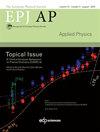基于压电传感器的机电系统容错控制诊断
IF 0.9
4区 物理与天体物理
Q4 PHYSICS, APPLIED
引用次数: 3
摘要
自动化系统容易出错。利用压电传感器和作动器进行故障诊断对振动控制系统的稳定性和容错控制技术具有重要意义。过程自动化中的故障经常导致意外的反应和受控工厂的关闭,其影响可能是对工厂的技术部分,员工或生态系统的破坏。容错控制是将诊断技术和控制技术结合起来,巧妙地处理故障。它提供了更好的可用性和最小化的安全风险。本文概述了研究和分析自动化系统的结构和其他基本特征的最新方法。因此,本研究的出发点是探讨异步电机的容错控制策略。最终,目标是实现干扰和/或容错控制,提高系统的功能可靠性。为了产生与振动位移相反的位移,研制了一种基于压电传感器和执行器的决策装置。它保证了控制的各种重新配置,以适应作用于系统的振动干扰和改变其特性。这将导致振动衰减。最后,分析了该方法的优点,确定了识别效果最好的故障诊断结果。本文章由计算机程序翻译,如有差异,请以英文原文为准。
Diagnostic of electromechanical system by fault-tolerant-control using piezoelectric sensors
Automated systems are fault-prone. The fault diagnosis via sensor and actuator piezoelectric is very important for the stability of the vibration control system and fault-tolerant control technology. Faults in process automation frequently lead to unexpected reactivity and the closure of a controlled plant, and the effects could be damage to technical parts of the plant, employees or the ecosystem. Fault-tolerant control is the combination between diagnostics and control techniques to cleverly handle faults. It provides improved availability and minimized safety risk. This article provides an overview of recent approaches to study and analyze the structure and other fundamental characteristics of an automated system. Thus, the starting point of this study was to investigate the Fault Tolerant Control strategy of an asynchronous machine. Ultimately, the aim is to achieve a disturbance- and/or fault-tolerant control, improving the functional reliability of this system. A decision-making device based on a piezoelectric (PZT) sensor and actuator has been developed to produce an opposite displacement to the vibratory displacement. It ensures the various reconfigurations of the control, adapted to the vibration disturbance acting on the system and modifying its characteristics. This will result in vibration attenuation. Finally, the advantages of this method are analyzed, and the fault diagnosis results with the best identification effect are determined.
求助全文
通过发布文献求助,成功后即可免费获取论文全文。
去求助
来源期刊
CiteScore
1.90
自引率
10.00%
发文量
84
审稿时长
1.9 months
期刊介绍:
EPJ AP an international journal devoted to the promotion of the recent progresses in all fields of applied physics.
The articles published in EPJ AP span the whole spectrum of applied physics research.

 求助内容:
求助内容: 应助结果提醒方式:
应助结果提醒方式:


